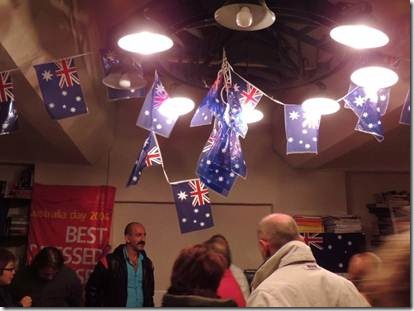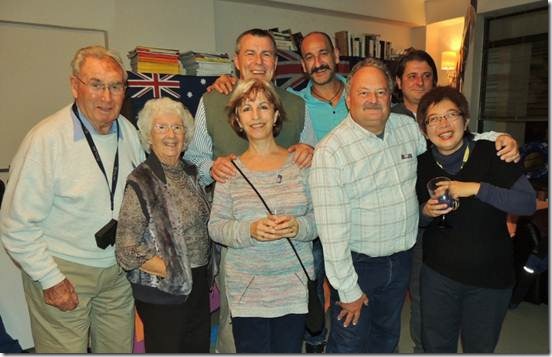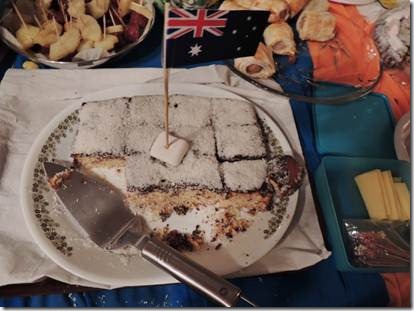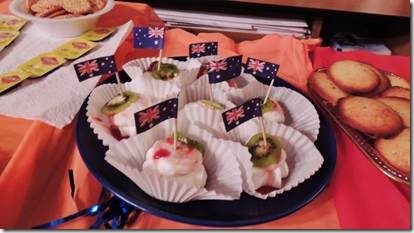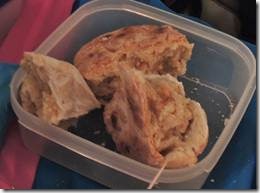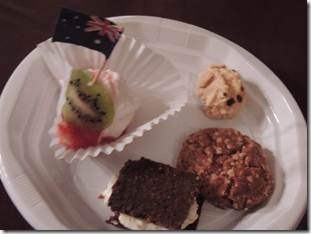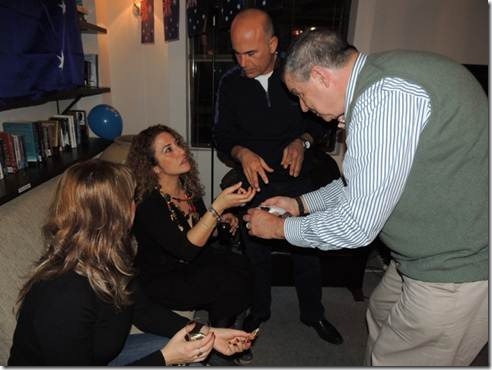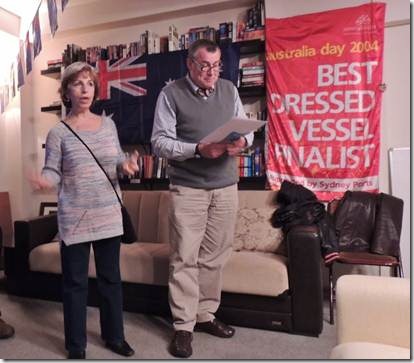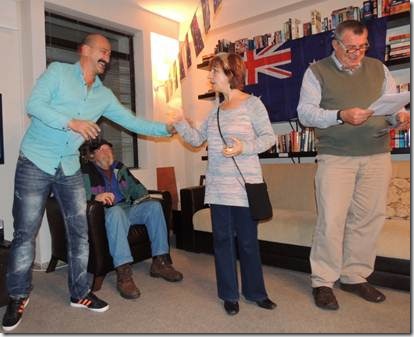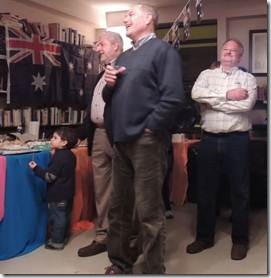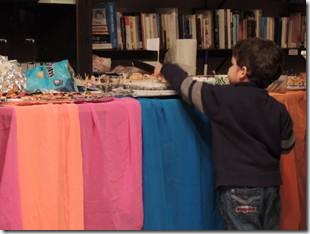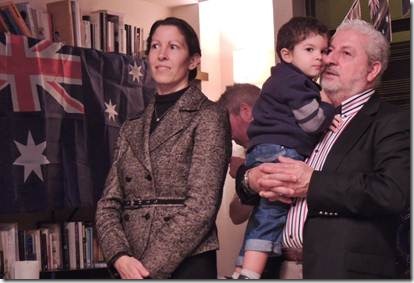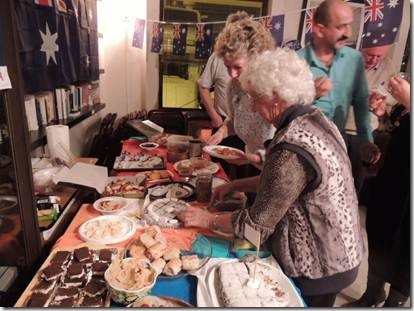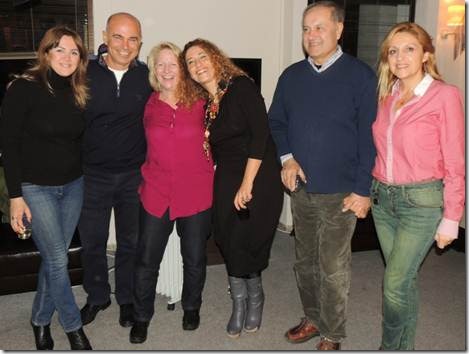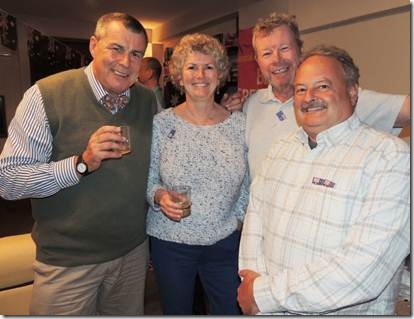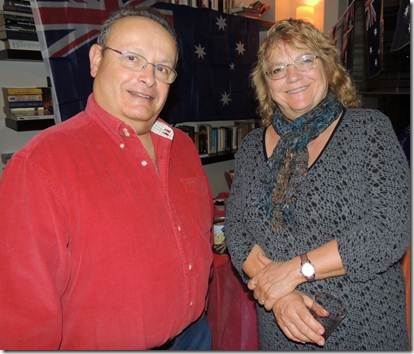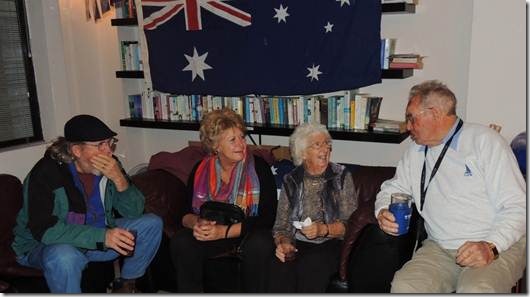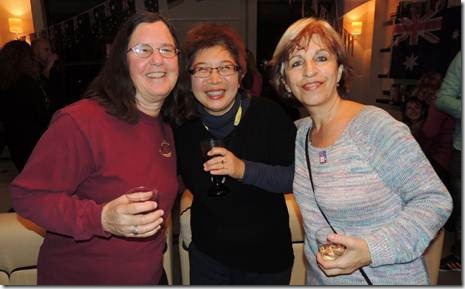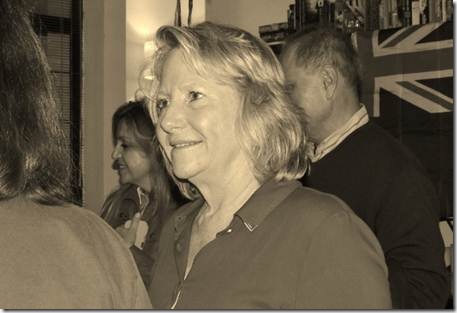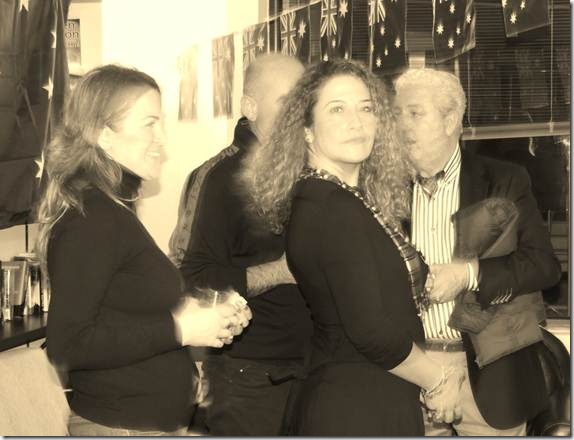G’Day Mates.. as this email is in celebration of Australia Day 2013.
“G’Day mate is probably the most widely known Australian term and is used when greeting your friend (cobber) or mate. … We all have ways to describe and comment on things we see or hear. Below are a few that you’re likely to hear in the land down under…
Holy dooley!: an exclamation of surprise = "Good heavens!", "My goodness!"
Give it a burl: try it, have a go
Good onya: good for you, well done
Grouse (adj.): great, terrific, very good
Rip snorter or ripper: great, fantastic
She’ll be right: it’ll turn out okay
Spiffy, pretty spiffy: great, excellent
You may be feeling a bit ‘gobsmacked’ (surprised or astounded) with all of this Aussie slang but it’s ‘fair dinkum’ (true, genuine). Australians can ‘yabber’ (talk a lot) so listen out for these sayings and it won’t be long before some of them creep into your vocabulary. Go on, give it a burl!”
http://www.topuniversities.com/country-guides/australia/g-day-mate-guide-australian-language
Though the get-together at Sailor’s Point was to celebrate Australia Day, one of the best parts was meeting the Turkish folks who are studying English with Cindy. Cindy is American. It’s her husband Peter who is Australian. They thought it would be a fun way for their Turkish friends to learn about Australian culture. A few of us Americans had a bit to learn also. At least I did. Did you know the dessert named Pavlova was created in Australia? And what’s Damper bread or an ANZAC biscuit. Read on.
Ru
DoraMac
Australia “Night” at Sailor’s Point
A slightly irreverent explanation : “Australia Day is more than just a public holiday. Whether you’re in the city, on the coast or in a regional area, there are thousands of events that celebrate everything that’s great about being Australian. The great thing about Australia Day is that it’s your day to do what you please, whether you’re into the local thong throwing contests, welcoming new citizens into our country or lazing about listening to some of Australia’s best musical talent.” http://www.australiaday.com.au/
And an even more irreverent description of Australia Day from the Huffington Post….
“Australia Day is a fun house mirror version of July 4. Instead of celebrating their independence from Britain, Aussies raise a pint to the arrival of the conquering Limies at Sydney Cove in 1788. Rather than wrapping their national day in patriotism and touting its historical significance, most Australians just go to concerts and enjoy the January sunshine.” http://www.huffingtonpost.com/2013/01/25/australia-day-10-great-things_n_2545754.html
Randal was in Australia during his World Bicycle Tour of 2000, but I’ve never been there; so what I know about Australia would fit inside a teaspoon packet of Vegemite. Pretty much anything I do know has come from movies , TV, and one or two books. And, except for Jill Kerr Conway’s memoirs; when I watched/read those movies, TV,and books, I wasn’t even trying to learn anything about Australia. I can recommend everything on the list below except for the movie Australia which I thought was terrible. Of course I was watching a pirated copy that was shot so poorly you could hardly see it. Serves me right for buying it!
Books:
Road From Coorain A Woman’s Education True North all by Jill Kerr Conway
Thorn Birds by Colleen McCullough
Movies and TV:
Adventures of Priscilla, Queen of the Desert
Australia
The Castle *
Dunera Boys
Gallipoli
Kenny *
Muriel’s Wedding
Proof
Rabbit Proof Fence
Ten Canoes *
Thorn Birds
A Town Like Alice
* These movies are quirky but worth watching
What I am learning about Australia really comes from meeting Australians as we’ve been cruising. And what’s more important about a country than its people? I think ultimately how we judge a country is by what we know (or think we know) about its people.
How could you not like a country with people like this?
|
Front Row: Bill Joan Zehra Kevin Mai; Back Row Peter Atilla and Alex May, Kevin, Peter, Atilla and Alex were all born in Australia. As a matter of fact, Atilla was the first baby of Turkish descent born in 1969 in Australia. Zehra lived and worked there for many years. Bill and Joan get to be in the photo because the spent all the time it takes to make the famous Australian Lamington Cake. |
|
Lamington or Lemmington Cake |
|
The word lamington means layers of beaten gold. An Australian dessert of little cubes or squares of sponge cake, dipped in chocolate, then rolled in coconut. In Victoria (State of Australia) they often add a layer of raspberry or plum jam. They are served with tea in the afternoon. Lamington’s are so popular in Australia that the cakes are a favorite means of raising money for school groups, churches, and scouts and girl guides. These money making adventure are called Lamington Drives. The cake is named after Charles Wallace Baillie, Lord Lamington, the governor of Queensland from 1895 to 1901. Lord Lamington was known for wearing a homburg hat that looked like the cakes. For many years lamingtons were served on state ceremonial occasions in Queensland. But Baron Lamington himself could by no means abide them. He invariably referred to them as “those bloody poofy woolly biscuits.” Another source recounts the slightly less dramatic circumstance of the baron’s cook concocting the dessert as a way to use up stale or slightly burnt sponge cake. According to Jackie French in her article titled Another History of Lamington, February 21, 2008: It appeared that lamingtons were invented in Brisbane around the early 1900s, probably by Amy Shauer who taught cooking at Brisbane central Technical College from 1895 to 1937. She also wrote three very popular cook books, and developed cookery courses for schools and colleges across Queensland, and was a famous cake maker and cake judge at Shows. It’s likely the first lamingtons were invented in Amy Shauer’s cooking class and named after Lady Lamington, who was the school’s patroness and extremely interested in education for girls. (One elderly correspondent, who remembered those days well, informed me that Lord Lamington was a pompous ass, and that no one would ever have named a cake after him. But Lady Lamington was much loved.) Before 1910, Australian cookbooks describe the Lamington as a whole cake iced in chocolate and coconut. Bite-sized lamingtons didn’t appear in cookbooks until a few years later, giving more impetus to the Lady Lamington story over the Lord Lamington one. According to Janet Clarkson and her blog The Old Foodie: One possibility is that the lamington is named after a locality, and there are three contenders: Lamington village (in Scotland), Leamington Spa (Warwickshire), and Lemmington (Northumberland). There are recipes for Leamington cake and puddings in some late Victorian cookbooks which are layered jam sponge-cake type mixtures, so the lamington could have developed from these. I hope this does not turn out to be the case, as it would be a very boring explanation. In Australian, July 21st was designated as National Lamington Day, and now it is celebrated mainly by charity groups to sell lamingtons to raise money. The Scots and the New Zealanders also claim credit. The Scots say it was a sheep shearer’s wife in the village of Lamington who made the cake for a group of traveling sheep shearers. New Zealanders enjoy lamingtons just as much as the Australians. They refer to the cake as leamington or lemmington, which are names of towns. |
|
Recipe for Lamington’s Cake….. |
|
“There’s no cake more Australian than the lamington, so celebrate Australia Day (or any day) with this delicious treat, a staple of all good fetes and fundraisers. “ Australian Women’s Weekly http://aww.ninemsn.com/food/8407334/classic-lamingtons INGREDIENTS 4 eggs 2/3 cup (150g) caster sugar 1 cup (150g) self-raising flour 1/4 cup (35g) cornflour 25g soft butter, chopped 1/3 cup (80ml) boiling water 3 cups (270g) desiccated coconut CHOCOLATE ICING 4 2/3 cups (750g) icing sugar mixture 1/2 cup (50g) cocoa powder 20g soft butter 3/4 cup (180ml) milk METHOD 1. Preheat the oven to 180°C (160°C fan-forced). Grease and flour a 20cm x 30cm lamington pan, line base with baking paper. 2. Beat the eggs in a small bowl with an electric mixer until light in colour. Gradually add the sugar; beat for about 8 minutes or until the mixture is thick. Mixture should form thick ribbons when the beaters are lifted. 3. Meanwhile, sift the flour and cornflour together three times. Combine butter and boiling water in a small heatproof bowl. 4. Transfer the egg mixture to a large bowl. Sift the flour mixture over the egg mixture; using a balloon whisk or a large metal spoon, gently fold the flour into the egg mixture, then fold in the butter mixture. 5. Pour mixture into prepared pan. Bake in a moderate oven for about 25 minutes or until sponge springs back when touched lightly in the centre and comes away from side of pan. Turn cake onto a wire rack to cool. 6. Cut cake into 20 even pieces. 7. CHOCOLATE ICING: Meanwhile, sift the icing sugar and cocoa into a large heatproof bowl; add the butter and milk; stir over a medium saucepan of simmering water until icing is smooth and thick enough to coat the back of a spoon. Divide icing mixture into 2 small bowls. 8. Place coconut in a shallow bowl. 9. Using a large fork, dip each piece of cake briefly into icing until cake is coated in icing. Hold over bowl to drain off any excess. Dip half the cake pieces in one bowl of icing and the other half in the second bowl of icing. (We have separated the icing into two bowls, as cake crumbs will thicken the icing and make it difficult to use.) If the icing becomes too thick, stand it over hot water while dipping, or reheat gently with a little more milk. If necessary, strain the icing into a clean bowl. 10. Toss cake gently in coconut. Transfer cake to a wire rack; stand until set. Suitable to freeze. Chocolate icing suitable to microwave. Note: The cake is easier to handle if it is made a day ahead or refrigerated for several hours. A sponge or a butter cake can be used for lamingtons. Lamingtons can also be split and filled with jam and cream, but this will make it a little more difficult to coat with the icing. |
|
And then there’s the Pavlova… |
|
Pavlova When the Russian ballerina Pavlova performed in Australia this dish was created for her and it became a favorite…or so Australians tell it. There it’s called a Pav. Mai made theses mini “Pav” and they were yummy! Mai made the Pavlova and she told me the story. Peter confirmed it so I didn’t even Google it because both Mai and Peter are Australian, so who is Google to argue. |
|
Damper Bread ANZAC Biscuit (cookie) 4 O’clock on the plate |
|
Damper Bread “Damper is traditionally a simple Australian unleavened bread baked in the hot coals of a campfire. The dough was wrapped around a stick and cooked or put into an iron pot and buried in the hot coals. The bread is called damper because the fire is damped to allow the bread to be cooked over the ash covered hot coals. During colonial times it was a staple food in the bush because the dry ingredients could be easily carried and they only needed to add water to make the damper. The original version had no sugar or butter and used water instead of milk so it was great on trips Damper Recipe Australian Damper Modern version to bake in the oven or try on a campout. Ingredients 2 cups self-rising flour ½ tsp salt 1-1½ cups milk 2 tsp sugar 2 tsp butter extra flour as needed Method 1.Mix the flour, salt and sugar together into a bowl. 2.Cut in the butter until fine crumbs form. 3.Add milk slowly and mix to form a soft dough. 4.Knead lightly on a floured board until smooth. 5.Shape into a round loaf, brush with milk and cut a cross in the top surface of the dough. . . . For oven cooking 6.Grease and dust with flour a round cake tin. You can substitute a flat baking pan, but the round tin gives a better shape to the loaf. 7.Place dough in the pan and bake at 190° C (375° F) for 30 – 40 minutes. . . . For campfire cooking 6.Grease the camp oven (Dutch oven) and dust with flour 7.Add bread dough and cover. 8.Place in your campfire, cover with hot ashes and coals and bake for about 30 minutes. Note: to test if it’s done, tap on the loaf and it should sound hollow. Cut into moderately thick slices and serve while still warm. Top with butter, golden syrup, or your favourite jam. Just for fun: A quick and easy method the drovers in the outback used to make damper is to wrap the dough around a stick to toast it over the coals. Fill the hole where the stick was with butter, golden syrup or jam. http://alldownunder.com/oz-u/food-recipes/damper.htm |
|
ANZAC Biscuits http://www.anzacday.org.au/history/ww1/anecdotes/bikkies.html The acronym ANZAC was coined in 1915 when Australian and New Zealand troops were training in Egypt. The word ANZAC was eventually applied to all Australian and New Zealand soldiers in World War 1. The term is particularly associated with the landing at Gallipoli on 25 April 1915. ANZAC Day was inaugurated on 25 April 1916 to commemorate the first anniversary of the landing of the ANZAC troops at Gallipoli. During World War 1 and World War 2, Australians were fiercely patriotic. This can best be described in the words, my country – right or wrong. The wives, mothers and girlfriends were concerned for the nutritional value of the food being supplied to their men. Here was a problem. Any food they sent to the fighting men had to be carried in the ships of the Merchant Navy. Most of these were lucky to maintain a speed of ten knots (18.5 kilometres per hour). Most had no refrigerated facilities, so any food sent had to be able to remain edible after periods in excess of two months. A body of women came up with the answer – a biscuit with all the nutritional values possible. The basis was a Scottish recipe using rolled oats which were used extensively in Scotland, especially for a heavy porridge that helped counteract the extremely cold climate. The ingredients they used were rolled oats, sugar, plain flour, coconut, butter, golden syrup or treacle, bi-carbonate of soda and boiling water. All these items did not readily spoil. At first the biscuits were called Soldiers’ Biscuits, but after the landing on Gallipoli, they were renamed ANZAC Biscuits. A point of interest is the lack of eggs to bind the ANZAC biscuit mixture together. Because of the war, many of the poultry farmers had joined the services, thus eggs were scarce. The binding agent for the biscuits was golden syrup or treacle. Eggs that were sent long distances were coated with a product called ke peg (like Vaseline) then packed in air tight containers filled with sand to cushion the eggs and keep out the air. As the war drew on, many groups like the CWA (Country Women’s Association), church committees, schools and other women’s organisations devoted a great deal of time to the making of ANZAC biscuits. To ensure that the biscuits remained crisp, they were packed in used tins such as Billy Tea tins. You can see some of these tins appearing in your supermarket as exact replicas of the ones of earlier years. Look around. The tins were airtight, thus no moisture in the atmosphere was able to soak into the biscuits and make them soft. During World War 2, with refrigeration in so many merchant navy ships, the biscuits were not made to any great extent as it was now possible to send a greater variety of food such as fruit cake. ANZAC biscuits are still made today. They can also be purchased from supermarkets and specialty biscuit shops. Around ANZAC Day, these biscuits are also often used by veterans’ organisations to raise funds for the care and welfare of aged war veterans. Compiled from information supplied by the CWA, Brisbane, the War Widows Guild, Brisbane and Queensland State Headquarters of the RSL A Favourite Recipe: 1 cup rolled oats 1 cup plain flour 1 cup sugar 3/4 (three-quarters) cup coconut 125g (4 oz) butter 2 tablespoons golden syrup ½ (half) teaspoon bicarbonate of soda 1 tablespoon boiling water Combine oats, sifted flour, sugar and coconut. Combine butter and golden syrup, stir over gentle heat until melted. Mix soda with boiling water, add to melted butter mixture, stir into dry ingredients. Take teaspoonfuls of mixture and place on lightly greased oven trays; allow room for spreading. Cook in slow oven (150°C or 300°F) for 20 minutes. Loosen while still warm, then cool on trays. Makes about 35. |
|
And then there’s Vegemite! Mine, Deniz, Ruṣen and Peter |
|
Peter’s wife Cindy teaches English and these three Turkish folks are some of her students who came to experience Australian culture. They didn’t hate it……. “Vegemite is uniquely Australian and a fair dinkum Aussie icon with 90 percent of Aussies having a jar in their pantry. Vegemite is a nutritious product, one of the richest sources known of Vitamin B. One of the most popular ways to eat Vegemite is to toast some bread, butter it and then spread on the Vegemite. If an Aussie is being honest with you, they’ll admit that it’s an acquired taste. With Vegemite, you either love it or can’t stand it. Our experience has been that if you’re raised eating it when you’re very young, you generally like it as an adult. We don’t know of anyone who ate it for the first time as an adult and liked it. In fact, when we’ve tried to get people visiting Australia to try it, they can’t get past the strong smell to try it. An American friend once told us that Vegemite looked and smelled like dried soup mix that comes in packets. With that image, I can understand why we couldn’t get her to try it. In any case, we love it! http://alldownunder.com/australian-food/vegemite.htm has lots more info about the history of Vegemite….. It even has its own song…. We are happy little Vegemites, as bright as bright can be, We all enjoy our Vegemite for breakfast, lunch and tea, Our mummy says we’re growing stronger every single week, Because we love our Vegemite, we all adore our Vegemite — It puts a rose in every cheek! We’re growing stronger every week! http://alldownunder.com/australian-music-songs/happy-little-vegemites.htm |
|
Just like the American 4th of July, besides food there’s speeches. We had ours in 2 languages…..Australian and Turkish. |
|
Zehar translates for the Turkish speakers. On a somewhat more serious note Peter explained the special relationship Australia has with Turkey based on their shared tragic history of Gallipoli. |
|
Atilla laughed as Zehra revealed that he’d been the first Turkish-Australian baby born in Turkey in 1969…..which made him one of the youngest people in the room! |
|
“You big people listen…I’m more interested in this food.” |
|
Ḡὒtὒ Volkan and Ercan I apologize for misspelling anyone’s name. Both are doctors here in Marmaris. Ḡὒtὒ told me she had moved to Marmaris from Istanbul for work. That is a huge change; like moving to Roanoke, VA from New York City… |
|
After the speeches it was Time For Food! |
|
I made the tiny sandwich; pumpernickel “brot” filled with a spread made of softened cream cheese, grated hard cheeses, grated apple and grated onion. They weren’t a big hit. Actually lots of folks thought it was some kind of pressed chocolate cake filled with something white. But like bikers, cruisers will eat pretty much anything so more than half were gone by the time Randal and I said good-night and I just left the rest to get eaten, taken or tossed. Maybe I should have added some Vegemite! |
|
Cindy’s English Language students: Mine, Ruṣen, Cindy, Deniz, Toros, and Ayṣegὒl (Again I apologize for any misspelled names.) |
|
Peter, Jane, Collin, Kevin Jane is just the best story teller. Ask her about the naughty duck! |
|
Lee and Joanne |
|
Randal, Gwen, Joan and Bill Joan’s family owned a circus in South Africa and Joan roller-skated on a skinny board in what was similar to a high wire act! At her next birthday she’ll be 90!!!! |
|
The “Netsels!” Mary, Mai, and Zehra |
|
Cindy |
|
“Turkish Ladies” |
No virus found in this message.
Checked by AVG – www.avg.com
Version: 2013.0.2890 / Virus Database: 2639/6060 – Release Date: 01/26/13

